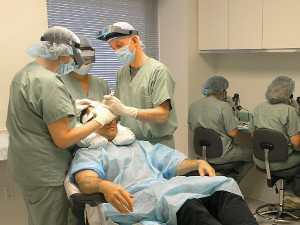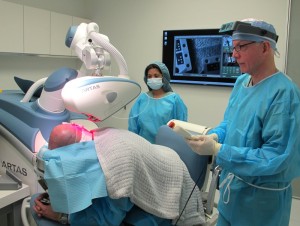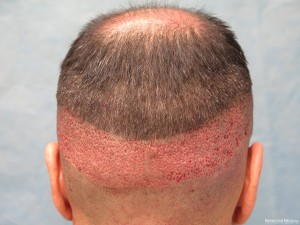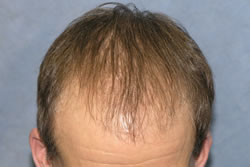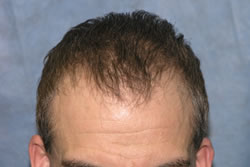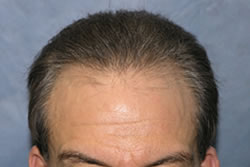Our Hair Transplant Services
Hair Transplant Benefits
Hair Transplant Process
Hair Transplant Candidacy
Hair Transplant Consultation Process
Hair Transplant FAQ
Schedule a Consultation
Hair thinning or balding can feel frustrating, but you don’t have to navigate it alone. At Bernstein Medical Center for Hair Restoration, our world-renowned team of hair transplant surgeons, led by Dr. Robert M. Bernstein, offers cutting-edge solutions tailored to your hair restoration goals. Using proven techniques and the latest medical technology, we help patients restore natural-looking hairlines, density, and confidence. Whether you’re addressing early-stage hair loss or seeking to correct a previous procedure, our team is here to guide you every step of the way.
What is a Hair Transplant?
Hair transplantation is a modern surgical procedure where hair follicles are relocated from the back or sides of the scalp (the donor area) to areas experiencing thinning or baldness (the recipient area). This procedure provides permanent hair restoration, with results that last a lifetime. Hair transplantation is most commonly used to treat androgenetic alopecia, the genetic form of hair loss. In addition to scalp restoration, hair transplant surgery can also be used to restore eyebrows, facial hair, and even repair scars caused by trauma or prior surgeries, such as face-lifts.
Our Hair Transplant Services
At Bernstein Medical, we offer several advanced hair restoration treatment options to fit your individual goals, hair type, and stage of hair loss. Each hair transplant technique we provide is backed by decades of research and experience, ensuring natural-looking, long-lasting results. Whether you’re looking for maximum density, a minimally invasive approach, or a solution tailored to corrective or cosmetic needs, our range of procedures offers something for every patient.
FUT Hair Transplants (Follicular Unit Transplantation)
Follicular Unit Transplantation (FUT) is the traditional method of hair transplantation and remains the gold standard for achieving significant volume. In this procedure, a strip of hair-bearing tissue is taken from the donor area, and individual follicular units are dissected under a microscope. These units are then placed in the recipient areas, which are prepped with tiny recipient sites. FUT is ideal for those seeking maximum coverage and who do not plan to wear their hair very short, as it leaves a small linear scar.
FUE Hair Transplants (Follicular Unit Extraction)
Follicular Unit Extraction (FUE), introduced by Dr. Bernstein in 2002, involves removing individual follicular units directly from the donor area without the need for a strip of tissue. This technique leaves small, round scars that are less noticeable than the linear scar left by FUT. FUE is beneficial for individuals who prefer shorter hairstyles or those concerned about scarring.
Robotic FUE Transplants
For unparalleled precision, we offer Robotic FUE using the ARTAS® robotic system. This cutting-edge technology aids in the extraction of hair follicles and the creation of recipient sites with exceptional accuracy. Robotic FUE is perfect for patients who want advanced care with fewer risks and complications.
Transplant Repair
If you’ve had an unsatisfactory hair transplant elsewhere, we offer corrective procedures to improve both aesthetic and functional outcomes. Our experienced team can rework unnatural hairlines, redistribute misplaced grafts, and improve scarring from previous techniques during our hair transplant repair.
Transgender Hair Transplants
Our transgender hair transplant procedures are designed to help transgender patients align their hairlines and density with their identity. We work closely with each patient to create personalized surgical plans that reflect their vision and support their transition journey.
Eyebrow Transplants
Thinning or misshapen eyebrows can be restored using your own hair. Our eyebrow transplant surgeons precisely implant individual hairs to create fuller, well-shaped brows that look and grow naturally, perfect for those with overplucked brows, scarring, or genetic thinning.
Hair Transplant Benefits
Hair transplant surgery offers several benefits, making it a popular choice for individuals seeking long-term solutions for hair loss:
- Permanent Results: Once transplanted, the hair generally grows for a lifetime.
- Natural Look: The use of follicular units ensures that the transplanted hair grows naturally.
- Boost in Confidence: Fuller hair enhances your appearance, offering a renewed sense of self-esteem.
- Low Maintenance: Unlike other hair restoration options, hair transplants require minimal maintenance after the procedure.
The Hair Transplant Process
Hair transplantation is a minimally invasive surgical procedure performed under local anesthesia in the doctor’s office or an outpatient facility. A typical session entails the extraction and placement of 300 to 3,000 follicular unit grafts. Procedures can last eight hours or more, and the longest ones are performed over two consecutive days. How long the procedure takes depends on the number of follicular units transplanted and the type of procedure used, with FUE generally taking longer than FUT.
Pre-Op
There are some minor preparations that must be followed in the days and weeks before surgery. Pre-op instructions include abstaining from smoking and aspirin one week before surgery and abstaining from alcoholic beverages for three days prior to the procedure. Instructions for the day of your procedure include showering and shampooing that morning and abstaining from caffeinated beverages. It is important to arrange for transportation following surgery as sedatives may be used that will preclude the patient from driving. These instructions differ slightly when preparing for FUT and FUE. We provide the complete instructions on our website in HTML and as a PDF download. Patients receive the instructions from the office as well.
The Surgical Procedure
On the day of your procedure, after reviewing the goals for your hair restoration, the doctor will redraw the hairline position that was determined at your consultation. You will have the chance to examine and discuss the plan before the surgery. Once you are ready, comfortable, and sedated (if you opt for it), the procedure will begin. There are three main steps to the transplant: follicular unit harvesting, recipient site creation, and graft placement.
Follicular Unit Harvesting
The first major step is harvesting follicular units from the donor area. In FUT hair transplants, the surgeon will excise a thin strip of hair-bearing tissue from your donor area and suture or staple it closed. The strip is then dissected into follicular units by a team of experienced technicians. In FUE, individual follicular units are extracted from the donor area one by one. This is the step that can best be done robotically. You can read a detailed overview of FUT here and Robotic FUE here.
Recipient Site Creation
The second major step is creating recipient sites – the tiny holes in the balding area where the harvested grafts are placed. In FUT and manual FUE procedures, the physician uses a needle to create hundreds to thousands of sites in the recipient area of the scalp. This must be done with precise aesthetic ideas in mind because proper recipient site creation is critical to the cosmetic outcome.
Some of the considerations in recipient site creation include the angle and depth of the incision, the size of the site, the density of sites, and the distance away from existing hairs. In Robotic FUE, a recipient site creation plan is programmed in advance by the surgeon, then the ARTAS Robot executes the site creation plan according to the exact specifications. It carries out this complex task with microscopic precision thanks to its advanced optical guidance technology. In performing site creation, the robot automates another part of the hair restoration procedure that can be prone to human error.
Graft Placement
Once recipient sites are created, special forceps are used to insert the follicular unit grafts into these sites. This step must be performed with care since mechanical injury to the graft or improper insertion into the site can inhibit growth. The ARTAS Robot does not yet have graft placement capability, so at this time, all procedures require a skilled and experienced team to manually place the grafts.
Post-Op
Patients must follow the post-operative instructions to ensure optimal healing and growth of the transplant. These include shampooing your scalp three times the day after your procedure (yes, it can be done this soon), showering twice a day for the first week, and abstaining from alcohol for three days and smoking for two weeks after the procedure. Read and download detailed post-op care instructions for your FUT transplant here or your FUE transplant here.
Post-Op Growth
Following the procedure, the growth of hair follows a specific sequence. Although the actual timing of each step is quite variable, for most patients it takes about a year to see the outcome of the hair restoration. Less commonly, it can take up to two years to see the final cosmetic result.
Soon after the surgery, transplanted follicles respond to the “insult” of the transplant by shedding the hairs they contained at the time of the transplant. The hairs may be lost, but the follicles themselves remain, and just 10 days after surgery, they are permanently rooted in the scalp. They generally begin producing new hairs in two to three months, although at first, the hair tends to be thin and sometimes wiry. At this time, some patients experience “shock loss,” a normal physiological response to scalp trauma in which existing (non-transplanted) hairs fall out in the vicinity of the transplanted hair. While this can be unnerving for patients, it does not imply damage to transplanted follicles, and the existing hairs generally grow back.
In the ensuing months, transplanted follicles will produce hairs that grow progressively thicker and appear more like normal hair. At one year, the final result of the procedure can usually be appreciated.
During the hair transplant procedure, hair follicles are taken from the part of the scalp that is most resistant to the progression of baldness. The transplanted hair can last for a lifetime; however, unrelated conditions may arise that can damage hair follicles, including the hair that is transplanted. This may be caused by a variety of medical disorders, dermatologic conditions, progression of balding beyond the norm, and changes related to aging. Treatment for these conditions can mitigate related hair loss, but may not always be successful.
What Age to Consider Surgical Hair Restoration
Young patients should not consider surgery as a technique to prevent hair loss, as it does not block the hormones that cause genetic balding. Rather, hair surgery is a restorative treatment to improve your appearance if other modalities have been unsuccessful or can’t be used.
There are no medical or surgical benefits to having a procedure at a young age. In fact, transplanting hair in young patients can create issues for the patient in the long term, such as depleting their finite supply of donor hair by distributing hair in the wrong areas of the scalp. Some young people will experience thinning in their donor area when they mature, and transplanting one of these people when they are young will most likely result in an unsatisfactory outcome. Unfortunately, this condition, called diffuse un-patterned alopecia or DUPA, cannot always be identified at a young age. As a result of these considerations, transplantation is not advised in patients younger than 25 and it is best to wait significantly longer.
Candidacy for Hair Transplants
Not everyone is a suitable candidate for hair transplant surgery. During your consultation, we will assess the following factors to determine if hair transplantation is right for you:
- Hair Loss Stage: You should have sufficient hair loss to make surgery worthwhile.
- Donor Hair Availability: There must be enough healthy hair in the donor area to ensure a successful transplant.
- General Health: Ideal candidates are in good health, with no contraindications to surgery.
- Realistic Expectations: It’s important to have realistic expectations about the results. Hair transplants can restore a natural appearance but won’t reverse genetic hair loss entirely.
Hair Transplant Candidacy Expectations
Surgical hair restoration should only be performed on appropriate candidates. This assessment occurs during a hair loss consultation with a physician. To be a candidate, five basic criteria should be met. These include:
- A diagnosis of androgenetic alopecia (common genetic hair loss) or another condition that is amenable to surgical hair restoration
- First explored medical therapy and, if appropriate, given adequate time to see a full response (generally one year)
- Sufficient hair loss that it affects their aesthetic appearance
- Adequate donor hair to satisfy current and future needs
- Realistic expectations on what surgical hair restoration can accomplish
The Hair Transplant Consultation Process
Every patient at Bernstein Medical must have a one-on-one consultation with a board-certified hair restoration physician to determine if they are a candidate for a hair transplant. At the consultation, the doctor will listen to the patient’s concerns regarding their hair loss, take a careful medical history, and ask about their expectations for the hair restoration. The patient will have plenty of opportunity in the consultation to ask questions about their hair loss and how best to treat it.
Densitometry and Miniaturization
During the consultation, the doctor may examine the patient’s scalp using a video densitometer, a device that magnifies the scalp, enabling the physician to see the quality of the individual follicular units. It is connected to a computer monitor so the patient can watch as the physician inspects their scalp. The densitometer helps the doctor determine the patient’s hair density (hairs per square centimeter) and the degree of “miniaturization” of those hairs.
In miniaturization, hair follicles that are genetically susceptible to the effects of the hormone dihydrotestosterone (DHT) shrink over time, eventually leaving a bald scalp. The degree to which hairs are miniaturized can indicate future hair loss. If hair follicles in the crucial donor area show signs of miniaturization, the patient may not be a suitable candidate for surgery because transplanted miniaturized hairs may eventually be lost.
Design and Planning
During the consultation, the physician will begin to make the necessary aesthetic judgments to formulate the design. These judgments include how best to distribute a finite amount of donor hair for maximum cosmetic effect, how to design the hairline, and how to restore the crown (when appropriate). The transplant design should be made in collaboration with the patient’s needs, but the plan must be a realistic one, taking into account future hair loss and the fact that everyone’s donor supply is finite.
Frequently Asked Questions About Hair Transplants
Is hair transplant surgery permanent?
Yes, hair transplant surgery provides permanent results. Once the transplanted hair follicles establish themselves in the new area, they continue to grow for a lifetime. However, it’s important to note that you may still experience some natural aging-related hair thinning over time.
Are hair transplants suitable for women?
Yes, hair transplants are effective for women experiencing thinning or baldness. While the pattern of hair loss differs between men and women, women can also benefit from hair restoration techniques to restore volume and density. It’s especially beneficial for women with female-pattern hair loss or those experiencing hair thinning after menopause.
Can hair transplants restore a full head of hair?
A hair transplant can significantly improve the appearance of thinning or bald areas, but the extent of restoration depends on individual factors such as hair loss severity and donor hair availability. It’s important to have realistic expectations regarding the amount of coverage, as the goal is to create a natural and fuller-looking hairline rather than a full head of hair.
Will there be visible scars after a hair transplant?
With the FUE method, the scarring is minimal and typically undetectable, even with short hairstyles. However, FUT may leave a small, linear scar at the donor site, but this is usually concealed by the surrounding hair. Scar visibility can vary based on hair type, color, and the skill of the surgeon.
Can I resume normal activities after my hair transplant?
It’s important to avoid strenuous activities for the first few weeks after your transplant to ensure proper healing. While light activities are generally safe, you should follow your surgeon’s guidelines for resuming physical exercise and other routines. Full recovery may take a few months, so patience is key during the healing process.
Schedule a Hair Transplant Consult
If you’re ready to regain a fuller head of hair and boost your confidence, Bernstein Medical Center for Hair Restoration is here to help. Contact us today to schedule your consultation and explore how our hair transplant surgery can deliver lasting results. Let us help you achieve the natural hair you deserve!


